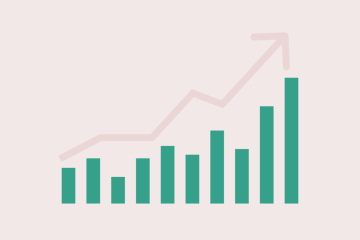
What is volatility?
Here, we explain what volatility means and why fluctuating stock prices can be both a risk and an opportunity.
6 min read
If you've ever invested in stocks, you might have wondered what volatility – or "Vola" for short – means. It's a good question because this percentage can help you better assess the risk of your investment. In other words, volatility indicates how much prices – in this case, your stock price – fluctuate. Here, you'll find out whether high or low volatility is better and what it means for your stocks, funds, or ETFs.Volatility measures the fluctuations in prices, stocks, interest rates, or markets over a certain period. It defines how much values – such as the price of a stock – vary around an average. The higher the volatility of a stock, the greater its fluctuations and the riskier the investment. But high volatility also has its advantages, which we'll cover later.In economics, volatility is considered a risk metric that can statistically measure price fluctuations. When prices rise and fall quickly, it naturally involves the risk of losing money, but also the chance of making quick profits. A significant movement – such as in stock markets – can have both advantages and disadvantages. Volatility, in any case, provides you with the right tool to better assess the risk of a stock.Let’s stick with our stock example. High volatility in a stock means that values fluctuate widely around the average, rising and falling sharply. In contrast, low volatility means that values stay close to the average, also known as the mean. Thus, prices only rise or fall moderately.Whether high volatility is good or bad depends on what you want to achieve. Are you willing to take risks and want to seize the chance for quick profits? In that case, high volatility is beneficial. It gives you the opportunity to make a significant amount of money in a short time. But don’t forget: the risk of substantial losses is equally high.The value of a stock with low volatility fluctuates only slightly. While you don’t have the chance for rapid returns, you generally don’t need to worry as much about major financial setbacks from plummeting prices. Securities with low volatility are, therefore, a relatively stable investment in comparison.Historical volatility indicates how much a price has fluctuated around the average in the past. The main difference from implied volatility is its predictive value. While historical volatility only tells you about past fluctuations, implied volatility looks to the future. It shows how price fluctuations are expected to develop and can, therefore, be used for forecasting.Volatility is a crucial risk measure for the stock market, indicating how prices are distributed in the market. For you as an investor, this information is extremely valuable, as it allows you to decide whether or not to invest in a security based on your experience and risk tolerance. By the way, rapidly rising prices in the stock market are known as a bull market, while quickly falling prices are referred to as a bear market.Periods of political and economic turmoil, in particular, can set markets in motion. Currently, for example, financial markets are reacting to rising electricity and gas prices, the increase in the ECB’s key interest rate, and the higher risk of a recession. This can also increase the volatility of a stock. Compared to other types of investments, stocks are especially susceptible to strong price fluctuations due to extreme changes, particularly in short-term buying and selling. In the long term, however, the condition of the company behind the stock is the main factor influencing its price.ETFs, or Exchange Traded Funds, are a specific type of fund traded on exchanges. The advantage of both investment types over stocks is that by investing in various securities at once, you benefit from diversification effects. This phenomenon, also known as diversification, helps spread risk. However, contrary to popular belief, many funds and ETFs also carry high volatility, although this is generally balanced out by long-term effects.The VDAX-New Index is a volatility index used to measure the fluctuations of Germany's main stock index, the DAX. It provides information on implied volatility—i.e., the expected fluctuation over the next 30 days. This volatility barometer reflects investor expectations at the EUREX derivatives exchange. At 30 percentage points, we are looking at a stressed market situation with highly volatile prices.Cryptocurrencies like Bitcoin, Ethereum, and others often experience significant price fluctuations within short time frames. These swings can be pronounced in both upward and downward directions. It's not uncommon for a cryptocurrency’s price to rise or fall by 10% or more in a single day. The high volatility of cryptocurrencies offers the potential for substantial gains in a short period, making it particularly appealing for traders who speculate on short-term price movements. However, as the potential for gains increases, so do the risks. Major price swings can lead to significant losses, especially for inexperienced investors. Additionally, dramatic price movements in either direction can lead to emotional decisions, further amplifying the risks. As with stock markets, there are efforts to measure volatility in cryptocurrency markets. The Crypto VIX is one such indicator, measuring expected volatility in cryptocurrency markets in a similar way to how the VIX does for traditional markets.While high volatility can indicate a higher risk for an investment, there are key differences between the two terms. Risk is a more subjective concept and represents the potential for financial loss. This can vary significantly depending on individual perspectives. Volatility, on the other hand, is more objective. It represents not only the potential for loss but also the opportunity for gains. In other words, volatility works in both directions. When a price fluctuates strongly, it’s not just a risk—it’s also an opportunity.Volatility calculations are typically performed by experts, so don’t worry if you’re not in that field. For those who want or need to know, the formula for calculating volatility is:Square root of: (1/n) * ((a-i)² + (b-i)²)The variable n represents the number of price values within the calculation period, and i is the average value. Variables a and b represent the individual price values.Let’s say you want to invest in securities. You have some knowledge of finance and would like to calculate the volatility of a particular stock yourself. Over the past six months, the price has fluctuated as follows:Month: €120 - €112 fluctuation; Return: -7.1%
Month: €100 - €120 fluctuation; Return: 20%
Month: €112 - €116 fluctuation; Return: 3.6%
Month: €128 - €125 fluctuation; Return: -2.6%
Month: €126 - €128 fluctuation; Return: 1.2%
Month: €116 - €126 fluctuation; Return: 8.2%To keep the calculation manageable, we’re only looking at a six-month period in this example. Calculating the average return gives us 3.9% – our value i. Plugging all values into the formula, it should look something like this:Square root of (1/6) * ((-7.1%-3.9%)² + (20%-3.9%)² + (3.6%-3.9%)² + (-2.6%-3.9%)² + (1.2%-3.9%)² + (8.2%-3.9%)²) = 8.5%Now you know that the volatility of this stock is 8.5%. You may now wonder whether this value is high or low. Looking back several decades, the volatility of European stock markets has consistently been around 20 to 30%, which might help with your assessment.
Definition: What is Volatility?
What Does Volatility Mean?
High Volatility and Low Volatility – Explained Simply
Is High Volatility Good?
Is Low Volatility Bad?
Historical Volatility and Implied Volatility – What’s the Difference?
Volatility in the Stock Market
Stock Volatility
Volatility of ETFs and Funds
Volatility Barometer DAX
Volatility of Cryptocurrency
Are Volatility and Risk Synonyms, or Is There a Difference?
How Is Volatility Calculated?
Stock Volatility – A Calculation Example
Invest from anywhere with N26
With N26, making your money work for you has never been easier. Smart, intuitive tools let you invest your money your way — whether you want to start trading, automate your investments, buy stocks, or get into ETFs. And there’s no paperwork — just full transparency and security.
Plus, with N26 Spaces subaccounts, you can easily set aside funds for your investments. Ready for the stock market? Trade, invest, and manage your money with confidence.
Find similar stories
BY N26Love your bank
Related Post
These might also interest youBANKING BASICSDear Money: an exercise for rewriting your financial scriptsWhether you feel stuck, anxious, or ready to make a change, writing a letter to money can help you reflect on and reset your financial mindset.
5 min read
INVESTBear market: This is what it meansIf you think a bear market sounds rather scary, you’re already on the right track. In this article, you’ll learn what a bear market is, why it occurs, how it affects your assets and how long it lasts.
11 min read
INVESTBull markets: What they mean for your moneyNot sure what bulls have to do with the financial world? The term is mostly symbolic — but bull markets can have significant effects on your investments. Read on to learn what a bull market is.
10 min read


